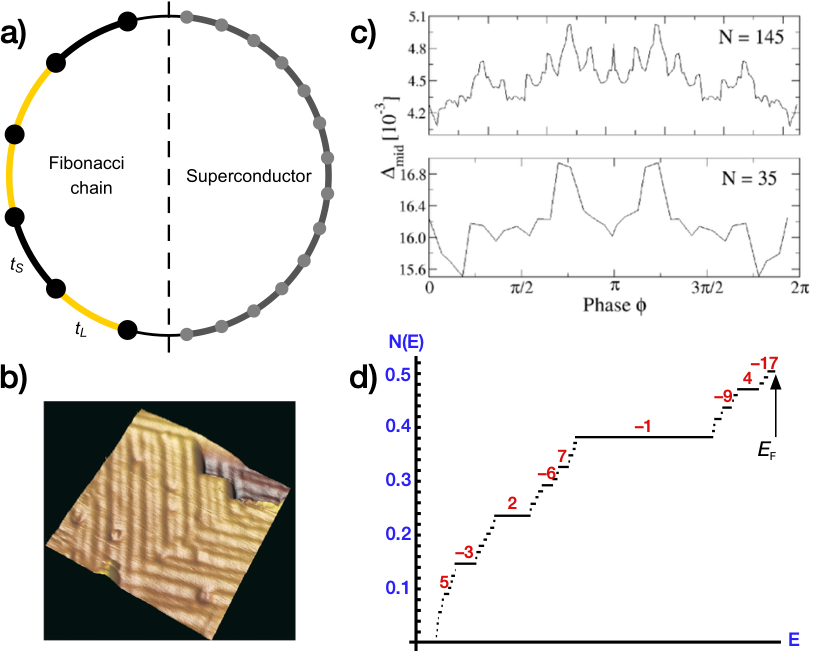Direct observation of topological properties of materials is now possible in experiments on mesoscopic samples, including measurement of “winding numbers” — which were until now considered rather abstract properties of the electronic band structure.
In a collaboration with physicists at USC we showed that the winding numbers in the Fibonacci chain, a one-dimensional quasicrystal, are manifested in oscillations of the superconducting order parameter induced by the proximity effect. These topological numbers are related to the Fibonacci numbers — a mathematical curiosity introduced in the 18th century by Leonardo of Pisa, with connections to the golden mean τ=(1+ √5 )/2 known as the “most irrational number”. Fibonacci sequences can be made with atoms by requiring that the distance between neighboring atoms have two values, L (for long) and S (for short) arranged according to a simple rule [1] in a type of ordering termed “quasiperiodic” : LSLLSLSLL….. Rather incredibly, the interatomic distances in some real quasicrystals have been seen to follow this type of sequence (see the copper ad-atoms on a AlMnPd surface in Fig.1b). We propose an experiment which consists of placing a Fibonacci quasicrystal next to superconducting material such as Pb in a ring geometry (fig.1a). The quasicrystal will develop superconductivity due to the proximity effect, and one can probe the gap at each of the sites of the chain with a scanning tunneling microscope tip. Fig. 1c shows the theoretically computed oscillations of the order parameter at the midpoint of two chains of different lengths as a function of a variable ɸ (for phase angle) [2]. When these oscillations are Fourier analyzed, one finds the integer periods: 17,4,9… These are precisely the winding numbers of edge states predicted by theory and they are related to the Fibonacci numbers in a simple way (for details see article). Our explanation of the observed oscillations is: each time an edge state sweeps through the quasicrystal – which it does q times per cycle – it leads to an increase of the superconducting order parameter. As the DOS in Fig. 1d shows, there are many gaps and corresponding edge states near E=EF which all contribute, leading to the complex oscillatory behavior seen in Fig.1c.

[1] Two short chains Cn-1 and Cn-2 can be placed together (concatenated) to form a longer chain Cn = Cn-1 ◦ Cn-2 : if we take C0=L and C1=L, then one gets the series of chains L, S, LS, LSL, LSLLS etc. The chain lengths are 1,1,2,3,5 … and are the Fibonacci numbers computed by the recursion formula Fn=Fn-1+Fn-2
[2] By varying the phase angle between 0 and 2π it is possible to generate all the N allowed Fibonacci sequences of a given number of elements N. In a pioneering experiment on edge states in a photonic Fibonacci chain by Tanese et al (Phys.Rev.Lett. 112 146404 (2014)) a complete set of such chains were fabricated for N=233.
Contact
Reference
Proximity effect in a superconductor-quasicrystal hybrid ring
Gautam Rai, Stephan Haas, Anuradha Jagannathan
Physical Review B 100, 165121 (2019)
doi:10.1103/PhysRevB.100.165121
